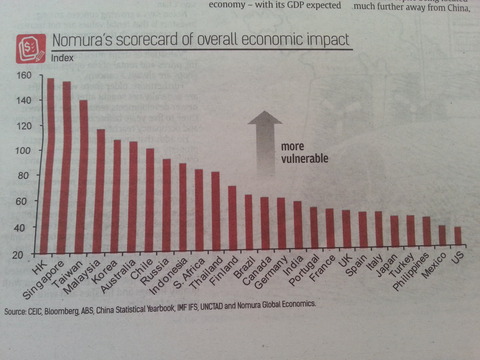Israel : Start-Up Powerhouse | ASIA TODAY News & Events

With a population of just eight million, Israel boasts 64 companies on Nasdaq. How has tiny Israel become one of the world's leading havens of innovation? What can Taiwan learn from Israel? And how are the two nations joining forces?
Jerusalem's Old City is a place of contradictions.
This is sacred ground for Jews, Christians and Muslims alike. One can walk the entire route from the Wailing Wall to the Church of the Holy Sepulcher to the Dome of the Rock in ten minutes. Yet there are seldom disturbances in the Old City; devotees of the various religions have learned to coexist peacefully, at least here.
Unfortunately, the same is not true in the world that lies beyond.
Israel declared itself an independent nation in 1948, with United Nations backing. Several subsequent wars with neighboring Arab nations in the 65 years since have cost the lives of tens of thousands of people and earned Israel a credible reputation as the arsenal of the Middle East.
Without getting into the right and wrong of things, Israel, with just 60 percent of Taiwan's land area and roughly one-third her population, has not only been able to survive, but has even earned grudging admiration as a "nation of start-ups."
The impetus behind the innovation, simply put, is survival. For decades now, Unit 8200 of the Israeli Intelligence Corps has put advanced technology to use gathering signals intelligence on hostile nations and has been instrumental in the creation of the Israeli information and communications technology industries.
In November of last year, Tel Aviv, Israel's commercial capital on the Mediterranean coast, came under Hamas-led rocket attack from Gaza, the Palestinian territory controlled by the extremist organization.
Responding to the situation, Israeli military commanders activated the nation's newly-developed "Iron Dome" air defense system, which successfully intercepted more than 80 percent of the incoming rockets.
Some days it rains, and some days there's a rocket attack – so it goes in Israel.
At the height of the attacks in a 24-hour Tel Aviv bar, young people still gathered to share their dreams. Don't for a moment, however, believe this to be an Israeli version of a Taiwanese nightspot. At 2 a.m. the young folks still hanging on here are still on the job. They're looking not for a good time but for business partners.
Per capita venture capital investment in Israel is 2.5 times that in the U.S. and 30 times that of Europe. The country averages one new business for roughly every 1,900 people.
Faced with the daily threat of enemy rocket attacks, people in many other countries might be hastily arranging dual citizenship or an immigration destination.
Why do the Israelis refuse to abandon their country, and how is it they are able to attract international investment capital to allow for the possibility of further development for future generations?
Chutzpah
Surrounded by hostile Arab nations, Israel was founded in strife and is brimming with dauntless start-up spirit.
Tal Ben-Shahar, an Israeli national and former professor at Harvard University who was in Taiwan this past month for a speaking engagement at the invitation of CommonWealth Magazine, says some of his earliest memories are of his father's role in the 1973 Yom Kippur War with Egypt and Syria.
As his father donned his battle fatigues and said good-bye, the three year-old Ben-Shahar bawled inconsolably. He carried on until a next-door neighbor told him: "If you cry, you cannot be a soldier like your father." For years thereafter, Ben-Shahar says, he was unable to shed a single tear.
Fortunately, his father returned safely from the war. Ben-Shahar went on to become one of the most popular professors at Harvard University, specializing in positive psychology and leadership psychology and authoring a series of books instructing people "how to be happier."
Israelis have a knack for squeezing the most out of life amidst perilous living conditions.
As Daniel Shechtman, the Israeli winner of the 2011 Nobel Prize in Chemistry, puts it, Israelis have a natural predisposition to chutzpah – fearless audacity – which imparts a strongly adventurous national spirit.
Israelis' natural ease at facing failure stands in marked contrast to the predilections of East Asian cultures, where people regard failure as a form of disgrace.
One must experience failure before one can be an experienced entrepreneur, Shechtman says.
Substantive Official Support
At the close of the 1980s, Israel had but one venture capital firm. In 1993, the Israeli government introduced policy incentives promising matching contributions from the Israeli government for every dollar that venture capital firms invested in the country. In effect, the government assumed half the risk.
Within 10 years, venture capital funds in Israel had multiplied 60-fold, from US$58 million to US$3.3 billion. The number of companies financed by venture capital grew from 100 to 800.
Israel has also encouraged the establishment of multinational venture capital funds. Often Israeli companies specialize in R&D while working with American partners that handle marketing and distribution, owing to their huge market.
Every major city in Israel now boasts its own "startup hub." Staffed by retired businesspeople offering their services free of charge, these centers offer local solutions to any difficulties aspiring entrepreneurs might face.
Israeli president Shimon Peres has also launched a number of projects to provide direction to youthful entrepreneurs.
For example, to spur nanotechnology research, Peres had nanotechnology research institutes established at six Israeli universities to serve as the foundation of the nation's nanotechnology industry. The operations of the research institutes are maintained through a "triangular support model," with government, universities and private institutions each providing one third of the budget.
This approach of casting a wide net allows the Israeli government to squeeze three times the impact out of its limited resources. The generous environment attracts top-flight talent. The resultant research then draws marked industry interest.
And thus the innovative momentum continues to snowball.
Figures from the Israel National Nanotechnology Initiative show that between 2007 and 2012, 88 nanotechnology experts from around the world immigrated to Israel to take positions at the nation's universities. During those years there were 625 academia-industry collaborative efforts resulting in 170 start-ups or approved patents, with an additional 704 patent filings pending, according to the Initiative website.
Focus on Hi-Tech & Exports
In response to the near total boycott by neighboring Arab nations, Israel has no choice but to focus on overseas exports, and its products tend to have characteristics reflecting that: compact, easy to transport over long distances and culturally adaptable.
Right from the start Israeli entrepreneurs were aware that Israel's market of eight million was just too small. They thus cast their eyes abroad. You can have innovative products, but if you can't get them to the rest of humanity, it's a dead end.
In an interview with CommonWealth Magazine, Giza Venture Capital founder and chairman Zeev Holtzman asserted that technological innovation is the cheapest because it costs nothing to put your brain to work.
"The human capital in Israel, not the natural resources, are the main resources," Holtzman says proudly, calculating that five to six dollars in export value has been created for every dollar he has invested in innovation.
Taiwan-Israel Alliance
Seeing the vibrant energy Israel has poured into research and its abundant venture capital experience, Taiwan has reached out to Israel.
Between 2004 and 2008, the Executive Yuan's National Development Fund committed to NT$1.3 billion in investments with Giza Venture Capital to promote technology transfer, strategic alliances and Israeli investment in Taiwan.
Aside from technology transfer agreements or strategic alliances with Israeli companies that have involved such Taiwanese companies as Taiwan Semiconductor Manufacturing Co., Alitech, CyberTAN and ASUS, Giza Venture Capital has acquired a five percent stake in Taiwanese solar wafer and solar ingot maker Danen Technology Corp.
But beneath the vitality there are private anxieties. Factors beneficial to start-ups, such as matching government investment funds for foreign investors, were at their apex at the close of the 1990s. These conditions no longer exist.
The biggest commercial challenge Israel now faces is identifying, aside from high-tech, that next wave of energy driving newly rising industries. Taiwan cannot afford to wait either.
Translated from the Chinese by Brian Kennedy
Goay Joe Lie













































